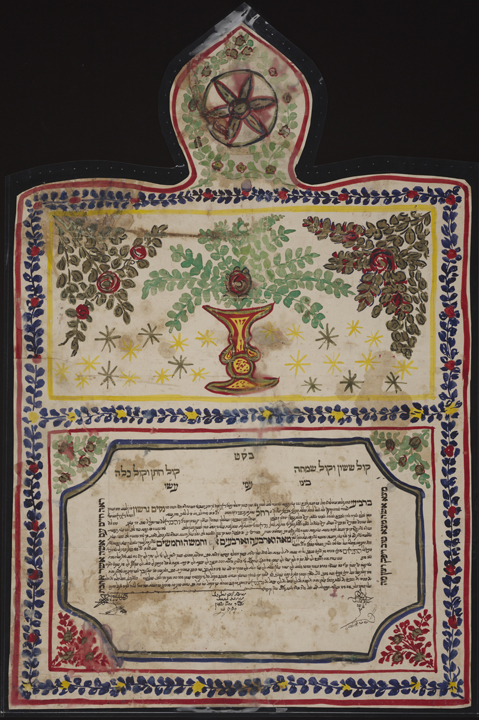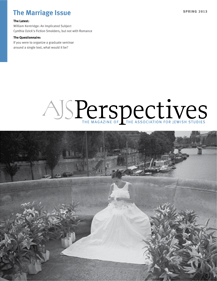
There are of course numerous ways to approach a generic topic such as “Jewish marriage.” One could focus on its history of myths and reality, as Paula Hyman has; on the extensive legal history of marriage arrangements and practices, as does Louis M. Epstein; or on the ways in which marriages among Jews have functioned in different eras or different geographical and social milieux. This essay, however, concentrates on the ways in which Jewish marriage participates in the socially and culturally constructed relations of power. These relations shape the hierarchies especially of gender but also of class that are more generally operative in traditional Jewish law (halakah). It is significant that since Talmudic times Jewish law has created a fundamentally unalterable corpus of law, at whose core is an unequal gender and power differential in which men control the privileged hegemonic center while women are marginalized, relegated to a different arena, namely, the domestic sphere, and denied the rights and privileges that men enjoy. Founded on biblical law, Jewish patriarchy has a long history, with a legal foundation codified in the Talmud by the rabbis, and its locus of power established firmly in the androcentric social system of traditional Judaism. The exilic turmoil of the Talmudic period might indeed have necessitated stringent standards and practices that added to the existing burden on women’s lives. Salo Baron notes that in order to implement communal cohesiveness in a threatening diasporic situation, leaders opted for rigorous rabbinic control of family life that included strict implementation of marriage and divorce laws, which affected family life and the legal status of women in a fundamentally patriarchal society. After the end of the Talmudic period, no beit din (rabbinic court) was universally accepted by all Jews—a sine qua non for legislation—so there was no possibility of altering the basic laws. The fact that there was no legislative prerogative to change the laws accounts for the fundamentally unalterable corpus of Jewish law and the inflexibility of marriage and divorce legislation. In addition, the exclusion of women from the most valued practice of Talmud study solidified a social system in which a group of men, the rabbis, determined the status and actual practices of women in the community.
Jewish law is generally contract-oriented, and Jewish marriage, which is not considered a sacrament, is a contract determined by halakah. According to the law of the United States and elsewhere, contracts may be executed bilaterally, but that is not the case in Jewish law. All halakic contracts are unilaterally executed, even though they may require the consent of both parties. Moshe Meiselman explains that the marriage contract is unilateral simply because there are “no bilaterally executed contracts in Jewish law”; and the man, that is, the husband, is the executor. Although there are no explicit legislative prescriptions about marriage in the Bible, which often uses the term “to take” to designate marriage, all the halakic laws about marriage and divorce are based on Talmudic interpretations of biblical texts. In Jewish marriage law, the woman is acquired by the man, a form of acquisition not unlike acquisitions in other contracts. Indeed, Boaz Cohen notes that the rabbis borrowed modes of betrothal from the “manner of acquiring a slave or real estate.” Although the acquired woman becomes the property of the man, she is not, according to Rachel Biale, the kind of property that can be sold like other acquisitions. Nonetheless, each man is the owner of his property, and only he—not the courts or the woman—can dispose of his possessions or nullify the marriage contract by divorce. It might seem as though the marriage contract only affects the status of the woman personally—which it does—but the loss of control has broader implications. After all, as Biale notes, marriage serves as “the instrument of control over economic fortunes, social status, sexual activity, and self-perpetuation.”
The serious consequences of the unalterable gender and power differential operative at the very foundation of the Jewish legal system do not end with the execution of the marriage contract. They are perhaps even more exacerbated should the wife, who cannot legally initiate a divorce, desire one. The biblical source for Jewish divorce (get) is Deuteronomy 24:1-2: “A man takes a wife and possesses her. She fails to please him because he finds something indecent about her, and he writes her a bill of divorcement, hands it to her, and sends her away from his house; she leaves his household and becomes the wife of another man.” The woman has to rely on her husband for a divorce because only he has the prerogative of executing and delivering a divorce, or get. There are, however, four reasons why a woman might not be able to obtain a divorce: (1) the husband is mentally incompetent and cannot grant a divorce; (2) he has died without legal evidence of his demise; (3) a recalcitrant husband refuses to divorce; or (4) he abandons his wife and disappears. The difficulty in releasing a woman from an undesired marriage derives essentially from the unalterable system of Jewish law rooted in gender and power inequality. Over the centuries there have been a number of rabbis and scholars who have tried to modify the marriage and divorce legislation in order to alleviate the onerous burden on wives, but their efforts were judged by other rabbinical figures to be halakically unsound or inadequate. There was a liberalizing period of about five hundred years (from about the seventh to the eleventh century) when Rabbi Gershom effected “for the first and unfortunately last time in Jewish jurisprudence” almost complete equality between men and women regarding the get: the husband’s right to divorce his wife remained intact and only he could prepare and deliver the get at will, but she was granted the right to demand a get and, should he refuse, to petition the court to compel him. But in the twelfth century, Rabbenu Jacob Tam, a French authority, ruled against any coercion of recalcitrant husbands and against the right of women to initiate divorce proceedings. Shlomo Riskin, among others, regarded Rabbenu Tam’s position as broadly acceptable because of the problematic social and political situation of Jews in the Diaspora where “small, cohesive Jewish communities, generally bound together by familial ties, isolated from the surrounding Gentile society by external anti-Semitism and internal religious strength” needed an inviolable marital bond. Rabbi Gershom’s liberalizing impulse was probably a reaction to the same social circumstances: he, too, was concerned with communal maintenance, but may have feared that women who could not obtain a get would seek conditions more amenable to them outside Judaism. Of course, it is also likely that Rabbenu Tam might have dreaded a weakened patriarchy undermined by gender equality.
Some responses to the inflexibility of Jewish law acknowledge the difficulties confronting the rabbis who might want—yet cannot—implement innovations in marriage and divorce laws. Unfortunately commiseration does not rectify the injustice. Reuven Yaron, a professor of ancient law, who speaks of encountering “again and again the same tendency to strictness, the same horror at going beyond the principles laid down by the Talmud,” also empathizes with the “anguish and regret of the authors, the conflict between their humane desire to help and the overriding obedience to what they consider their duty.” Furthermore he realizes that “this is poor consolation indeed for the woman whom the decision might condemn to a life of celibacy,” not to mention of course the shame, ostracism, and the loss of self-esteem and status she would suffer. Not a word of criticism, however, about the patriarchal system whose laws permit such violence against women. From another perspective, Blu Greenberg, a conservative feminist, acknowledges that the rabbis who “did not go the final step in equalizing divorce law” were not guided by a concern for gender inequality but by “principles of paternalism and hierarchy.” Yet, according to Greenberg’s apologetics, the rabbis “cannot be faulted, given the almost universal nature of sexual hierarchy.” Sexual and gender hierarchy is, however, not a natural phenomenon but a socially and politically constructed one and, as such, can be constructed differently. In fact, it was possible for Rabbi Gershom in the Geonic period to make significant gains in parity and protection for women that lasted for half a millennium. Moreover, explanations by a number of scholars that the actions of the rabbis solely concern the well-being, protection, and status of women seeking a get seem hollow, even disingenuous. In closing, let me say that I have been drawn to multicultural concerns within Jewish Studies—be they different legal systems; structures and operations of power among various groups; social and political effects of gender, class, and status inequities; or the nexus between larger institutional constructs like community or family and individual predicaments. But that route proved problematic because a decidedly inflexible aspect of Jewish family law was under consideration. The methodological concerns and theoretical versatility of cultural studies usually focus on challenging and exposing the authority behind structures of domination, with the expectation of abolishing or at least reducing the power inequities that often lie concealed in both public and private spheres. It is, however, ironic and more than a little disconcerting that, while these approaches to the study of Jewish marriage and divorce laws expose the operative gender asymmetries of power, they also reveal the impossibility of altering or undoing them, given the fundamentally inflexible patriarchal Jewish legal system and culture.

